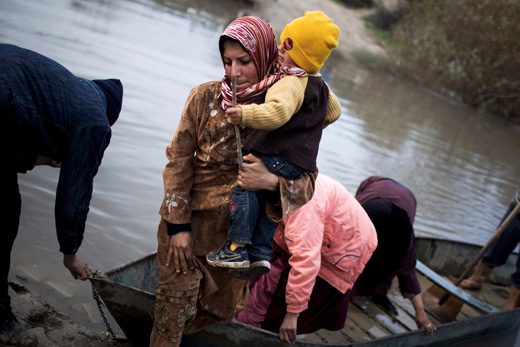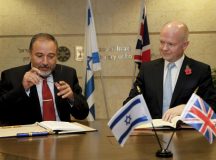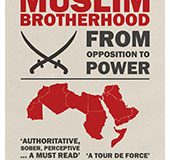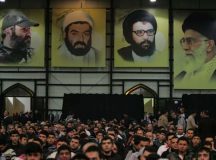The end of the Assad regime will probably not mark the end of the civil war but a new phase: an ethnic-sectarian battle. The conflict forms a central front in a broader Sunni-Shia clash throughout the region.
The Syrian civil war has claimed upwards of 40,000 lives, and shows no signs of ending any time soon. However, the stalemate that has prevailed since August, 2012 has been broken. The regime of President Bashar Assad is clearly in retreat – a large swathe of northern Syria has effectively been ceded to the disparate forces of the rebellion who, as I write in late 2012, are laying siege to remaining islands of regime control in Aleppo and Idlib governates.
The crack-up continues
The regime, meanwhile, is contracting, and seeking to establish new defensive lines. Assad’s forces are trying to create an impenetrable ‘security circle’ around the capital city Damascus, ceding rebel-held eastern suburbs and fiercely defending the remainder.
At the same time, Assad is building an additional defensive line in the Orontes River valley, west of the majority Sunni cities of Homs and Hama. This appears to be part of a strategy whereby if Damascus falls, the regime will seek to maintain control of an area of Alawi majority population in the west of the country, from where it will continue its fight against the Sunni rebels.
If the capital city falls, this will effectively mark the end of the Assad regime as it has existed since 1970, but it will probably not mark the end of the Syrian civil war. Instead, the conflict would then likely morph from an uprising against a dictatorial regime by a popular rebellion into an ethnic-sectarian battle between forces representing the Sunni Arab majority of the country, and the army of the former regime, which would effectively have become an Alawi militia. The ethnic sectarian nature of this second chapter in the Syrian civil war will be further marked by the existence of an additional ethnic enclave in the country, maintained by Kurdish militias – the PYD, the Syrian Kurdish franchise of the PKK organisation, is dominant – in the majority Kurdish north east of Syria. The regime effectively facilitated the establishment of this enclave when it withdrew from five Kurdish majority towns in August 2012, allowing the PYD to enter. Some analysts saw this move by the regime as part of a larger rapprochement between the Assad regime and the PKK. However, the PYD and PKK flatly deny the existence of any such rapprochement. It is equally likely that the regime, short of manpower and aware of the Kurdish desire to avoid involvement in a rebellion widely seen as pro-Turkish and Islamist in nature, reached local understandings with the Kurdish forces in the area in question and quietly withdrew.
The Syrian rebels are committed to the maintenance of the territorial unity of the country. Senior rebel leaders have openly proclaimed their intention of re-conquering the Kurdish enclave in the north-east. They would also be determined, of course, to crush an Alawi enclave in the west, should the remnants of the Assad regime seek to establish such an entity, as looks likely.
Is this second phase of the war immediately imminent? While the regime is certainly in retreat and growing weaker, it is not yet in headlong flight. The core, Alawi-dominated, Praetorian Guard type units of the Syrian Arab Army remain loyal to the regime. The 4th Armored Division and the Republican Guard, both commanded by the president’s brother, Maher, remain intact and available for use, as do the regime’s special forces, and the ‘Shabiha’ Alawi irregular forces.
The regime also maintains its dominance of the air, though a number of aircraft have now been downed by the rebels. And of course it also retains control of Syria’s extensive chemical and biological warfare capabilities.
All this means that the Assad regime may well hold its current lines for some months to come. But if and when Damascus falls, the next phase is likely to be a continuation of the civil war.
Proxy conflict
The Syrian civil war has been a proxy conflict from its outset. The Assad regime is a central regional ally of the Islamic Republic of Iran. This alliance has been a key factor in enabling the survival of the regime; a large body of evidence, confirmed by statements from Iranian officials themselves, indicates that the Iranians have offered money, advice, materials and men to help the regime survive.
Not only Iran itself, but also Iranian allies and clients such as the Hizballah organisation in Lebanon, and the Maliki government in Iraq have acted to assist the beleaguered Syrian dictator. Hamidreza Taraghi, an Iranian pro-regime politician, recently characterised Iran’s motivation for aiding the Syrian regime in the following terms: “Whatever the cost, we want to keep Syria in the group of resistance against Israel.” The rhetorical element in this statement aside, it is a pointer to a crucial element which has enormously benefitted Assad. The other secular nationalist dictators in the Arab world who fell in the context of the ‘Arab spring’ – Bin ali in Tunisia, Hosni Mubarak in Egypt, Ali Abdullah Saleh in Yemen, Muammar Gaddafi in Libya – were all either aligned with the west or isolated.
Assad is the only leader of this type who was aligned with the anti-western, Iran-led bloc in the region, and he has survived longer than any of the others thanks in no small part to this affiliation. The other dictators had no international line of support to enable them to sustain a policy of brute force and repression against their own populace. Iran has been willing to play this role for Syria.
There are currently no indications that Iran is planning a major shift away from this position of support for the Assad regime. Given the Sunni Islamist and fiercely anti-Iranian stance of the Syrian rebels, it is unlikely that Iran will have many options in this regard. This is particularly so given recent indications of the Syrian civil war spilling over into Lebanon, where Iran’s main proxy in the Levant – Hizballah – is located. In the Lebanese towns of Tripoli and Sidon, there have been clashes between Sunni Islamist supporters of the Syrian revolution and local Hizballah activists. Hizballah fighters have also engaged in action across Lebanon’s eastern border in support of Assad. Should the rebellion conquer Damascus, these clashes may intensify, as Lebanese Sunnis see a chance to challenge the dominant position that Hizballah currently holds in the country.
This dominant position has derived in no small part from the presence of the pro-Hizballah Assad regime in neighboring Syria. Should the sectarian war spill over decisively into Syria, Iran will have increased motivation to continue its backing of the Alawi regime.
Russian support has also been crucial – both in terms of continued arms provision, and in diplomacy, where Moscow has acted to prevent a coherent international response to the Syrian crisis through the exercise of its veto in the United Nations Security Council. On the rebel side, international support has been patchier, but has also played a key role in defining the nature of the insurgency and in enabling the rebellion to pose a real challenge to the regime. The main providers of support to the Syrian rebels are Qatar, Turkey, Saudi Arabia and the Muslim Brotherhood movement.
Western countries including the United States, Britain and France have also offered varying degrees of support for the Syrian opposition. But it is the support of Sunni movements and regimes which has made the largest impact on the nature of the insurgency.
The rise of the Islamists
For their own reasons, Qatar, Turkey, Saudi Arabia and the Muslim Brotherhood have predictably favored Islamist fighting groups in Syria over more secular-inclined ones. This, coupled with the greater commitment of the Islamists in the fighting itself, has led to the increasing dominance of the Islamists in the rebel ranks and the decline of secular commanders.
The recent formation of a unified rebel command, with western support, around two-thirds of which consists of the Muslim Brothers and their allies, reflects the predominance of the Islamists. Secular nationalist commanders, including Colonel Riyad Asaad who founded the FSA and Generals Mustafa al-Sheikh and Hussein Haj Ali, were excluded from the new command. The composition of the new command mirrors that of the new, also MB-dominated civilian leadership for the opposition, announced in Qatar in November.
In the event of continued conflict in Syria, the Sunni Islamist rebels will enjoy the continued support of Sunni regional powers. In the event of their victory and taking of power in the country, the new Syria is likely to be Islamist in nature, and to align with other Sunni Islamist states in the region.
There is, however, also a real possibility that following the fall or the contraction of the regime, the Sunni rebels may begin to fight among themselves. Already, a more hard-line, rival military command has been formed in opposition to the western supported alliance. The rival command favors a more thorough Islamist approach and includes some of the most effective military units among the rebels, including the al-Qaida affiliated Jabhat al-Nusra.
The rebellion has been notable for its lack of unity since its outset. Thus, if and when the regime loses Damascus, there is a real possibility that the continued conflict will not only be between Sunni rebels and Alawi and Kurdish enclaves. Rather, different elements among the rebels may begin to challenge one another. There have already been instances of internecine conflict among the rebels, for example over the issue of the border crossings of Bab al-Hawa and Bab al-Salameh between Syria and Turkey.
Conclusion
The Syrian civil war does not look close to an immediate conclusion, and it may well shortly enter a new phase. While it is of course not possible to predict the precise course of events, two factors may be stated with a degree of confidence: the war will continue to be characterised at its core by its sectarian nature, and it will continue to be a proxy war, in which the mainly Shia, Iran-led regional alliance will back the regime or remnants of it, while the Sunni rebels will be backed by a looser alliance of regional Sunni powers.
In this regard, the conflict in Syria forms a central front in what is emerging as a broader Sunni-Shia clash, discernible throughout the region, along the faultlines that separate areas of Sunni and Shia Arab population (which do not, of course, resemble the lines dividing Middle Eastern states from one another). This clash has been much exacerbated by the Arab upheavals of the last year and a half, because of the rise of Sunni Islamist movements in a number of countries. Thus, an arc of Sunni-Shia conflict can now be drawn, beginning in Lebanon, taking in Syria, Iraq, Bahrain, Kuwait, the eastern province of Saudi Arabia and going down to north Yemen.
From Israel’s point of view, the prospect of the fall or severe contraction of the Assad regime contains both positive elements and potential new threats. On the one hand, Israel has long identified the Iran-led regional alliance as its most potent adversary. The two ‘active fronts’ of the Israel-Arab conflict over the last decade – Hizballah in south Lebanon, and Hamas/Islamic Jihad in the West Bank and Gaza Strip – were characterised by a heavy investment by Iran in Israel’s Islamist adversaries. The fall of Assad would mean a major, strategic setback for Iranian ambitions in the Levant area. This surely is a benefit for Israel.
But on the other hand, the likely period of chaos in Syria that would follow the fall of Damascus and the rise of Sunni Islamism are both of deep concern. There have already been instances of gunfire from southern Syria towards the Golan Heights. Though so far these appear to be stray ordnance from fighting between the army and rebels, Israel is acutely aware of the large numbers of Syrian and foreign salafi (extreme Sunni Islamist) fighters playing a vital part in the fight against Assad. The presence of these men, and the likely anarchy in a post-Assad Syria would bring with it the possibility of attacks across the border. The possibility that Assad’s chemical and biological warfare capabilities could fall into the hands of such groups is also a major Israeli security worry at the present time. In short, both a Syria in chaos and a Syria in which the Sunni rebels managed to consolidate their rule would bring new challenges for Israel.
The views of the Sunni rebels regarding Israel are in line with those of other Sunni Islamists: the consensus is one of extreme hostility to the Jewish state. This does not mean that a Sunni Islamist Syria would immediately embark on a path of direct confrontation with Israel. But it does mean that such a regime would be likely to be a strong ally of Hamas, and of the Muslim Brotherhood regime in Cairo. This would make any advance toward peace between Israel and Syria extremely unlikely for the foreseeable future.




































